Stacy Speyer recently completed a residency at the Exploratorium in San Francisco. For the Exploratorium’s traveling exhibition Geometry Playground, Speyer created an interactive exhibit of metal geometric forms known as polyhedra. Subsequently she began work on a book on this subject called Understanding Polyhedra. Speyer was trained as a textile artist (MFA California College of the Arts) and is known for her large scale open weave installations. She is the Studio Manager of the Textiles Department at California College of the Arts in Oakland.

Whirligig: What is the connection between your work in textiles and polyhedra?
Stacy: There is an underlying grid in the make up of all fabric woven on a loom, but the different weave structures possible on a loom can create a huge variety of patterns and kinds of fabrics. My favorite weave structure is called plain weave and it is the one I usually use for my loom woven artwork. It is the simplest structure and when done in the light open way I weave, the woven grid is revealed. Though it is visually layered by the colourful composition dyed into the threads. It depends on the viewer’s interest whether they are caught more by the details of colour or the organic woven.
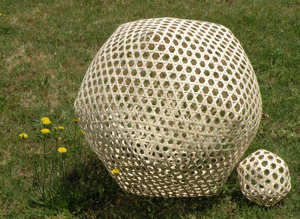 The start of all this polyhedra making, was a curiosity with a basketry technique, a hexagonal weave structure. It has three elements instead of the two in a basic grid that I am used to on the loom.
The start of all this polyhedra making, was a curiosity with a basketry technique, a hexagonal weave structure. It has three elements instead of the two in a basic grid that I am used to on the loom.
I liked the odd number of basic elements, one horizontal and two diagonals, that come together to make this regular structure. When all three elements meet, they make a small equilateral triangle and a set of two in three directions form the sides of a hexagon.
One year I worked out how to make the structure flat and the next year I tried making it into a basket. Then I wondered if I could close it off, making all the ends meet in some kind of spherical shape.
Spheres have always been a big part of my work but usually just seen as circles of dyed colour in the cloth or when the form the fabric is hung in an arc and column.
Whirligig: What are polyhedra and how did you come to be interested in them?
Stacy: My research into how to make a round form made of triangles and hexagons became a study of spherical shapes made of polygons. These shapes are called polyhedra, poly = many, hedra = faces. They are 3D forms built up of many 2D shapes.
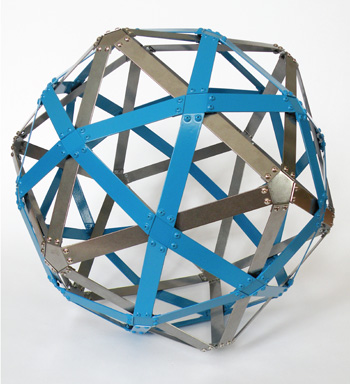 Then began the time of my polyhedra problem, when I would stay up all night taping together a bunch of polygons to see what the form would look like. This is also when my passion for reading (and of course buying) math books developed.
Then began the time of my polyhedra problem, when I would stay up all night taping together a bunch of polygons to see what the form would look like. This is also when my passion for reading (and of course buying) math books developed.
There is a precise and limited mathematical definition of regular polyhedra. Many of the basic shapes have been known since Archimedes and some were mentioned by Plato, but there is so much room to make them in your own way. Although their form is geometrically regular, the same elements are repeated everywhere over the whole form, they seem to shift beneath your eyes while you turn one in your hand or watch it grow as you make it. Each one becomes more than its definition and is so different from every angle.
My fascination with how polyhedra appear at different angles, combined with an obsessive attempt to thoroughly document the pieces I made for the Geometry Playground, led to me making a book. It has over 200 pictures of the 15 finished pieces, playful permutations of them in progress, and ones with similar symmetries connected together. For those who want to understand the forms, it begins with an introduction to polyhedra, which includes watercolour paintings and pictures of paper models of the different shapes. For those whose favorite past time is not studying, the layout of the book develops in away that reveals the associations between forms without having to read about the icosidodecahedron and its dual the rhombic triacontahedron.
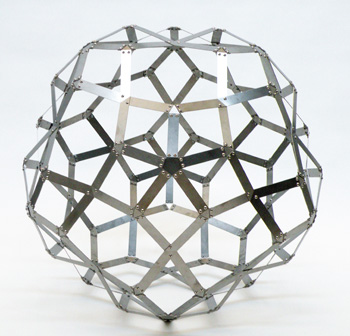
For me, studying polyhedra is the perfect blend of artistic and intellectual inquiry. I enjoy learning about math, the making of the forms keeps teaching me new things about structure, and, when I am done, I have this delightful object which I can enjoy for its beauty or for how it fits into the geometric scheme of things.
Besides all the different materials and ways that one can re-make the basic forms, there are many more complicated shapes which exist at stages in-between the known forms. Few people have made these more complicated forms and an infinite number of less regular shapes are possible that may never have been seen before.
There is also a connection between my weavings and geometry pieces in the aspect of how I work, which is only visible to other weavers and those who know my process. Much algebra, number play, and counting are involved in every weaving I do, as well as months of research and planning.
Whirligig: Tell us about your residency at the Exploratorium: What drew you to it?
Stacy: Serendipity, my favorite collaborator, is what drew me to the Exploratorium. I was deeply immersed in this material when I heard about the project. It was last calls for Artist in Residence—they were just at the end of a series of interviews with artists—when I sent them off a light preview of the forms I’ve been making.
Although, I had made a few interesting objects, the majority of what I had been focusing on were structural investigations. Some basic and some very elaborate, but nothing I wanted to send off to a gallery for a show.
Whirligig: How did the residency experience affect both your process and product?
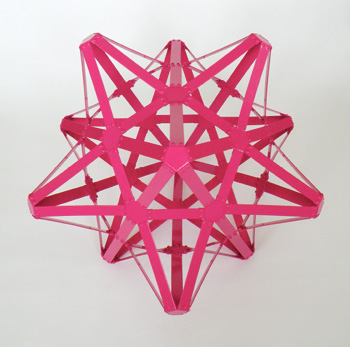
Stacy: This residency was such a special experience for me in so many ways. The people who work at the Exploratorium are spectacular. I loved being surrounded by so much focus on science, math, different ways of learning and making, and I had such a good time beginning immersed in a group of people who were just as curious about everything as I am.
I was intimidated by how far I had to go from the research I had done to the kind of quality piece I wanted to have in The Geometry Playground project. I had about six months before the two month residency began and I worked hard experimenting during that time. My research was amped up, for both informational “book knowledge” and in physical experimenting.
The wonderful people at the Exploratorium gave me some essential nuts and bolts conversations about what would be the best ways of making such precise and regular geometric forms. After a few experiments, it was obvious that I needed the computer to help me make what I wanted. I had been using Illustrator to help me make the regular polygons in paper and plexiglass, now for this project I created files in Illustrator to make pieces in metal. I adored working in strong sturdy metal, but the resulting forms were still very light and airy. I never could have done this work without the dialogue, goal, shop resources, and funding of this project.
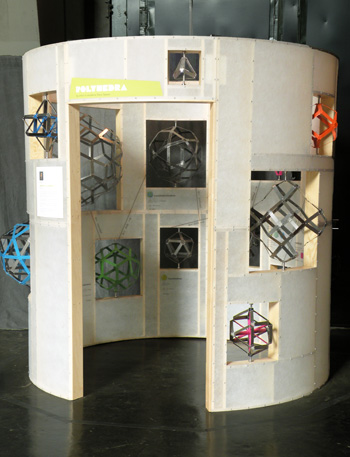
My process of working a year or more on most projects, did not change for this residency. But I had never worked so collaboratively before. Although the choice of forms and their construction was all done by me, the idea for the final installation came from my point person, at the Exploratorium. Though I spent hours designing the arrangement of the pieces and the informational label that is in the inside for it, the Exploratorium crew had their own architect involved in designing the structure of the final installation, their graphic design people re-do the graphics in InDesign, and their crew constructed the exhibit and installed the pieces in it. The final form is a small round room with different sized windows cut into it holding the forms. Each piece has a dowel attached to the top and bottom so that it can spin on its center axis—for those interested in studying the forms, being able to turn them is essential, it is also really fun to watch them spin round.
My original goal was to make a room (preferably a polyhedral shape) that you could walk into and it would have a selection of polyhedra that could be turned. The end result, a translucent cylinder with 15 forms some in colour, some with a black polish, and some steel gray was very different from what I had imagined but it has an affinity with my other work. I think the person I was working with was inspired by my art and he kept making suggestions that brought the final display form closer to it.
Constantly communicating with so many people who were all working with me to make the very best object possible was a new and fascinating experience for me. Goals would sway between making something that was more about my art and something more practical for the traveling exhibit and will keep the continuity of the rest of the show.
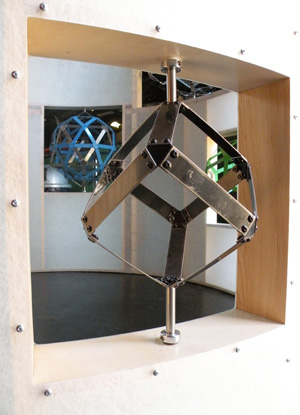
The two month residency became almost a year of working at the Exploratorium. I had less time to devote to the project when my job at CCA started up again. I also teach an evening weaving class at the Richmond Art Center, and I was taking a Pre-Calculus Class. The project was slowed down and I spent a lot of time thoroughly documenting each piece which turned into its own project.
Whirligig: What (seemingly) lasting thing did you take away from it?
Stacy: I left there with a way of making polyhedra objects that feels like my art work and with so many directions I would like to pursue. My next step is to find funding for more work because getting that metal cut is pricy. I’d like to be able to experiment with forms a bit more, but again have the end result be a large piece to be installed somewhere. I prefer making something for a specific place, so that where it will be installed influences its form and feel.
Whirligig: What are your influences?
Stacy: I am inspired by many things, including architecture. Being from Chicago, I am fascinated by big tall buildings and how the feel of a space can influence one’s mood in it. The immersive experience is something I think about a lot: walking into a space, the amount of light and openness.
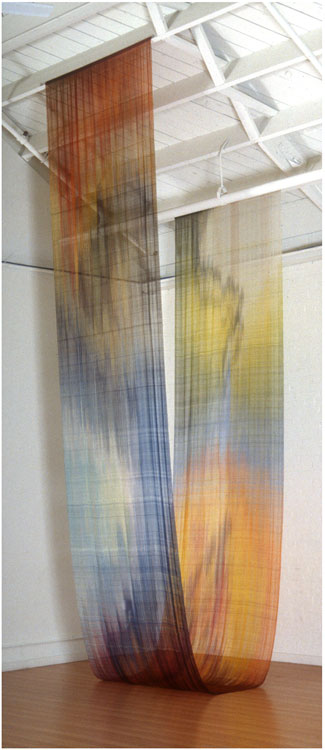 The weavings have speed in their long lines which, when hung floor to ceiling, almost seem to flow down through the floor and continue to stretch on through the ceiling, endlessly to infinity. They are made almost more of air than of actual materials. Structurally it is a grid, which we use to describe space in a plane. But, by not weaving a solid piece of fabric, these pieces break down the plane and connect to the way that our world is also made up of open space.
The weavings have speed in their long lines which, when hung floor to ceiling, almost seem to flow down through the floor and continue to stretch on through the ceiling, endlessly to infinity. They are made almost more of air than of actual materials. Structurally it is a grid, which we use to describe space in a plane. But, by not weaving a solid piece of fabric, these pieces break down the plane and connect to the way that our world is also made up of open space.
I am inspired by ideas of science, fascinated with molecules and atoms, especially electrons: the invisible whirling energy that you can’t see and that forms our solid world. Ignoring the idea that a true understanding of particles may be impossible, thinking about those kinds of ideas are a huge influence on my work.
Whirligig: Who do you find to be provocative and interesting in the Bay Area or International art scene?
Stacy: Although I enjoying seeing current art, made by art students or professional artists, it often doesn’t inspire me to make similar artwork. I like being up on the current flavor of the art scene and seeing the trends move, but inspiration tends to come from an internal space. My abstract work is often an expression of a concept (scientific, mathematical or philosophical) explored through colour and composition. The ideas become a code that is experienced more as a feeling than trying to communicate an exact thought. I like the open ended nature of this because I can make work that has many different meanings to different people. More people can connect to it and enjoy it.
Whirligig: Your day job as the Studio Manager of the Textiles Department at California College of the Arts revolves around contemporary art education. What’s that like and how does that feed your own work?
Stacy: It is a very demanding job. My responsibilities include (but are not limited to) fixing and getting new equipment, supplies, budgeting, technical support (and occasionally emotional support) for the three main areas that go under the Textiles umbrella: weaving, printing and fiber sculpture. I help disseminate information in between the school administration, teachers, and students. There are a million things to do every day and I never seem able to catch my tail.
Just like all artists, it is a challenge to still have energy to create at the end of a hectic day. The pace can be crazy and the pay is not so good, but I do treasure being in such an environment. Working at an art school means that I hear about the latest trends in art, can watch subtle changes in students’ interests, and am constantly being surrounded by people thinking, talking and making art work. There is a community of people who I can ask technical and conceptual advice, and a number of resources I can use, if I have the energy to use them. But it is really hard to go back to work at the end of the day to use these great resources. Also, anytime I am on campus, people tend to see me as their resource. I can’t tell you how often I’ve had to tell a student, that no, I’m not working right now, it is 1am, I am just trying to work on my own project. Can they please ask me about that during normal business hours?
I would really like to get a teaching job, that was the point of getting my MFA, but full-time college level teaching positions in Textiles are not that common. Applying to a teaching position means moving out of the Bay Area, which I would be very sad to do. Also, in past years, when I have been in the middle of a two year art project, I didn’t feel like I could leave until it is completed.
Whirligig: How does the Burning Man experience feed or affect your creative process?
Stacy: Burning Man is the perfect eye candy. Costumes and camps inspire the textile artist in me. Then the domes make the geometer happy, and the large scale art feeds my dreams of what can be done with a lot of hard work and good vision. Also, all those years of seeing things lit up all night long, and recently learning about conductive fabric and thread, has led me to take a class on kinetic art with electronics and computers. We shall see where that goes. . .
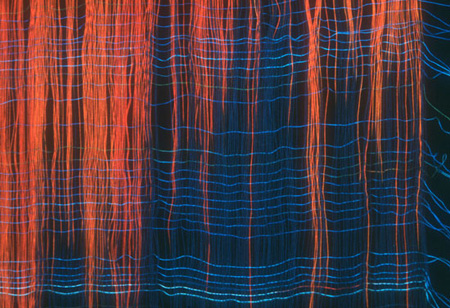 Whirligig: What do you dream of creating and why?
Whirligig: What do you dream of creating and why?
Stacy: My goal for a long time has been to make really large-scale work, but it needs to have meaning to me, be structurally sound, and be something worthy of existing on that scale and in that place. I’ve been moving steadily towards it, but I’m not in a hurry. I know I could just increase the scale on something and have a ready to go big piece, but I want its scale to be an intrinsic part of the piece. My current experiments include developing lattice structures. I’m always drooling at the open lacy geometric structures that are used in bridges. I want to make work where the form and structure are in harmony and the big scale to be the best way to experience the idea.
Each piece I make tends to begin with a question and the making of the piece is an attempt to answer a question. This work based on geometric research has captivated me because it is like Hercules cutting off one of the heads of the Hydra and getting that one head replaced with a few more. Every time I seek to answer a question by making a structure, I just seem to find more questions that I am excited to pursue.
Whirligig Interview by Nanette Wylde.
Stacy’s website: stacyspeyer.com
Images from the top: As Above So Below; Natural fiber polyedra; Icosahedron inside an Icosi-dodecahedron; Expanded Rhombic Tricontahedron; Pink Stellated Dodecahedron; Installation for Geometry Playground; Cube; Elemental; One. All images courtesy and copyright Stacy Speyer.
